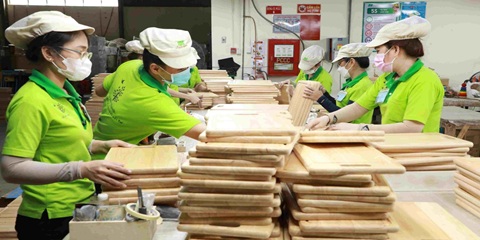Want to be in the loop?
subscribe to
our notification
Business News
FRESH PORT CHARGES HIT CITY’S LOGISTICS
Despite strong objections among businesses, Ho Chi Minh City will start collecting infrastructure and service fees at seaports from July 2021, triggering concerns over logistics cost increases.
Nguyen Tuong, deputy secretary general of the Vietnam Logistics Business Association (VLBA) said, “The fee collection is a strong blow to businesses, especially import-export and logistics ones. Despite disagreement, they can do nothing but follow it. This will increase logistics costs and reduce our competitiveness.”
Ho Chi Minh City People’s Council on December 9 approved a resolution on collecting public infrastructure and service fees at seaports. The subjects to the fee collection include units and individuals with temporary import for re-exports, merchandise in transit, commodities in transit, goods in bonded warehouses, and those that are importers and exporters using infrastructure at seaports (see box).
Fee collection will begin next July at Cat Lai Port and then at others in the city. This is expected to bring about revenues of over VND3 trillion ($130 million) to the city annually.
Tran Quang Lam, director of Ho Chi Minh City Department of Transport, said that the proceeds will be used to reinvest in transport infrastructure development to ease jams at seaports. “The fees are built in line with the prevailing rules on fees. We learned from other cities which have similar conditions such as Haiphong,” he said.
Lam cited statistics saying that the volume of cargo handled by local seaports in 2019 reached 170 million tonnes, accounting for more than a quarter of the country. Many seaports are facing capacity limitations due to underdeveloped infrastructure, with Cat Lai being an example.
The new fee collection may also help ease overloads at Cat Lai Port and others, and prompt businesses to rethink about other seaports. Currently, businesses from the southern provinces of Dong Nai and Long An prefer to route their cargo through Cat Lai instead of other ports such as Hiep Phuoc in Ho Chi Minh City and the Cai Mep-Thi Vai port area in the southern province of Ba Ria-Vung Tau.
In spite of that, experts said that logistics costs in Vietnam remains high, making up for 20 per cent of the country’s GDP, while other countries ranged from 9 to 14 per cent. Therefore, the additional fees would cause more financial burdens for them.
The Vietnam Textile and Apparel Association (VITAS) said inflated logistics costs were already hampering the competitiveness of Vietnamese goods. Vietnam’s logistics costs are 6 per cent higher than Thailand, 7 per cent higher than China, and 12 per cent more than Malaysia.
“High logistics costs do not only reduce the competitiveness of goods, but also create an obstacle for businesses to enter new markets,” said a VITAS representative.
In addition to this, competitiveness could be also reduced as the new fees would prompt businesses to make other choices. “Businesses in Quang Ninh, Long An, and elsewhere may select other seaports to cut costs,” Tuong explained.
The battle between fee increases and logistics costs in Vietnam has remained a drawn-out one. While the government has been taking actions to fulfil targets of reaching annual logistics growth rate of 15-20 per cent and reducing logistics costs to 16 per cent of GDP, cities and provinces often announce such a fee increase for various reasons.
Ho Chi Minh City is not the first to make the move. In 2017, the northern city of Haiphong began collecting infrastructure and service facilities fees at seaports, and it is estimated to fetch about VND1.6 trillion ($69.56 million) annually from the collection.
Source: VIR
Related News

A STELLAR CHRISTMAS AT SOFITEL SAIGON PLAZA
Experience the magic of year-end celebrations in five-star luxury, where Parisian elegance meets Saigon’s festive vibrancy. Discover your Stellar Christmas moments: https://sofitel-saigon-plaza.com/festive-offer-2025

CONSTRUCTION SECTOR POSTS OVER 9% GROWTH IN 2025
Industries under the ministry’s management accounted for an estimated 17.23% of national gross domestic product (GDP), up about 0.17 percentage point from 2024. They contributed around 1.96 percentage points to overall GDP growth, reported the Vietnam News Agency. The contribution helped push Vietnam’s economic growth to above 8% in 2025 and supports the Government’s aim of pursuing double-digit growth in the coming years.

VIETNAM PUTS PUBLIC INVESTMENT DISBURSEMENTS AT VND603.6 TRILLION
Vietnam’s public investment disbursements had amounted to VND603.6 trillion in the year to December 18, equivalent to 66.1% of the plan assigned by the prime minister. According to the Ministry of Finance, actual disbursements by December 11 had totaled VND577.7 trillion, or 63.3% of the prime minister-approved plan of VND913.2 trillion, the Vietnam News Agency reported.

SHINE INTO 2026 AT HOIANA RESORT & GOLF!
This New Year’s Eve, celebrate where the sea meets the sky. Vibrant performances, festive dining, DJ beats, live bands and dazzling fireworks come together for one unforgettable night. From beachfront countdown moments to curated New Year’s Eve dinners across Hoiana, every detail is designed to welcome 2026 in style.

VIETNAM’S TRADE SET TO SURPASS US$900 BILLION FOR FIRST TIME
Vietnam’s total import-export turnover is expected to reach about US$920 billion by the end of the year, marking the first time the country’s trade value has exceeded the US$900-billion mark. As of December 15, Vietnam’s total trade turnover stood at US$883.7 billion, according to the Agency of Foreign Trade under the Ministry of Industry and Trade.

GLOBAL SOURCING FAIR VIETNAM 2026 – THE TRULY GLOBAL B2B SOURCING SHOW IN VIETNAM TO EXPAND & DIVERSIFY YOUR EXPORT MARKETS WORLDWIDE
The 4th edition of Global Sourcing Fair Vietnam returns in 2026 with an impressive scale, featuring 700 booths showcasing Fashion & Accessories, Home & Gifts, and the newly introduced Printing & Packaging Products from 500+ verified suppliers across Vietnam and Asia – including Mainland China, Taiwan, Hong Kong SAR, South Korea, India, Bangladesh, ASEAN, and more.
























